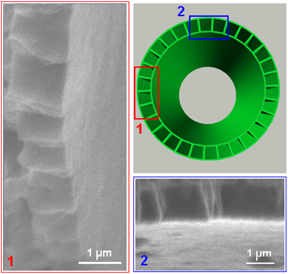
A carbon nanotube of micrometer dimensions offers the same conceptual challenge as does a jumbo shrimp: How can something so small become large, yet remain in its category?
A relatively huge, lightweight carbon tube with good strength and electrical properties is desirable, all right, because it can be manipulated in the far more accessible micrometer regime.
But is it still a nanotube?
Jianyu Huang (1132) at the Sandia/Los Alamos Center for Integrated Nanotechnologies (CINT), and colleagues elsewhere, got around this problem by naming their new creation “colossal carbon tubes” in a paper published in an October issue of Physical Review Letters.
“The structures are remarkable because they are very light, possess good electrical conductivity, and have mechanical properties similar to carbon fibers,” Jianyu says.
Among possible uses are so-called textile electronics and body armor.
Because of their strange, surprising sponginess — walls of graphite-like carbon kept apart by hollow, rectangular compartments — the colossal fibrous tubes have a density of 0.1 gram, compared with 2 grams for the comparable amount of carbon fibers.
The colossal tubes are about the same length as carbon fibers — in the centimeter range. And they appear to be slightly stronger — a very desirable, and until now unheard of, property in large carbon tubes.
MIT carbon technology specialist Mildred Dresselhaus was quoted in an online news column of the journal Nature: “This is a new form of carbon that was unexpected to me.”
Jianyu, who did the microstructure analysis that confirmed that the walls of such tubes consist of graphitic structure, describes the new creation as “a porous, giant, carbon fiber-like tubular structure” of diameters ranging from 40 to 100 micrometers. Conventional carbon nanotubes are about 10 nanometers in diameter.
The material was made at Los Alamos National Laboratory. Researchers there led by Yuntian Zhu and Huisheng Peng found that heating ethylene and paraffin oil produced a carbon vapor that condensed into tubes of pure carbon tens of micrometers wide and up to several centimeters long.